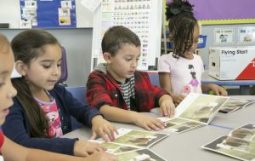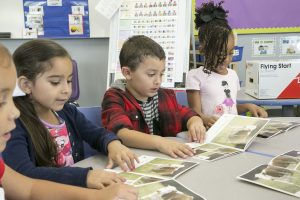Shared Reading vs Guided Reading
In Shared Reading, students learn what they will later apply in Guided Reading. Shared Reading and Guided Reading lie alongside each other within a gradual release of responsibility model of instruction. One of the key ways Guided Reading instruction differs from other small reading groups is through this relationship to shared reading instruction.
Shared Reading vs Read Aloud
Along with read aloud (sometimes referred to as Instructional Read Aloud or Interactive Read Aloud), Shared Reading is often thought of as the time for demonstrating comprehension, strategies, and skills in the context of a known text. While the thinking work a reader does is present in all reading experiences, shared reading differs from read aloud in that an enlarged copy of text is available so that all eyes are being directed to the piece of text connected to the instruction. Through Shared Reading, students learn what they later apply in Guided Reading.
Shared Reading texts are meant to be read and revisited multiple times. The text is experienced first as a whole text—a narrative, an informational piece, or an explanation, for example—with big ideas and construction of meaning the main purpose of the students’ first exposure to the text. (This is a very supported reading.) Teachers revisit the text to uncover deeper meanings and highlight the skills and strategies needed to navigate the print and get to this meaning. Each subsequent visit to the text asks students to take on more of the reading work, as students are invited to join in. As the text becomes more and more familiar, skills and strategies needed to be demonstrated are based on observations of students in guided reading lessons. In essence, this text becomes a mentor text not just for ideas but for print-related elements as well.
A teacher will also examine Shared Reading texts closely to consider the future work for groups of readers in Guided Reading. As a teacher thinks toward the upcoming weeks of instruction, she or he will consider the series of lessons needed so the text is familiar to students and the possible shared reading demonstrations and experiences to come, preparing students for future guided reading experiences. A teacher may also bring texts that have been used in past shared reading experiences back into the reading time to demonstrate additional skills or strategies.
Without Shared Reading, students are often unprepared for the challenges they meet in Guided Reading. Teachers are offered a time and place for teaching into those challenges when shared reading and Guided Reading are considered together. Debra Crouch.


